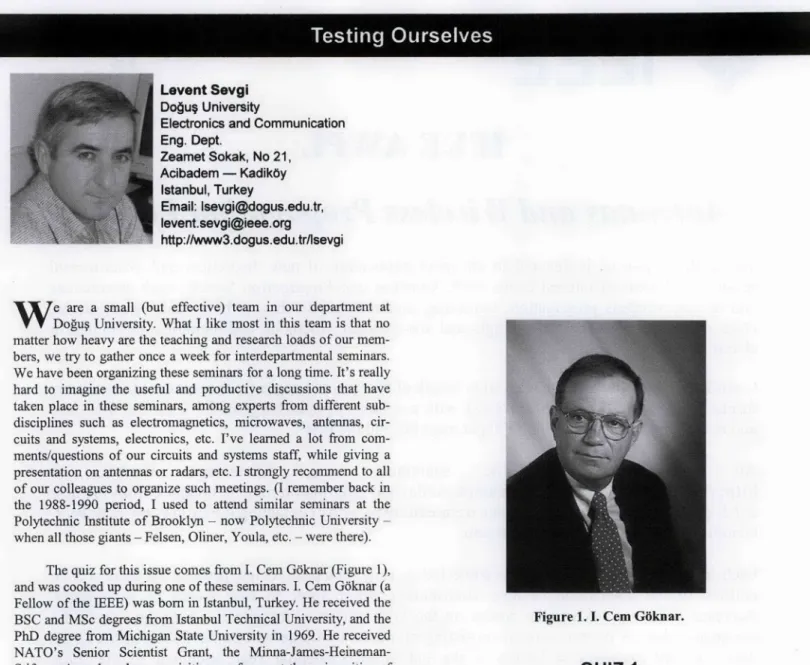Testin Ousle
Levent Sevgi Do~uV University
Electronics and Communication Eng. Dept. Zeamet Sokak, No 21, Acibademn - Kadik6y Istanbul, Turkey Email: lsevgi@dogus.edu.tr, levent.sevgi@ieee.org hftp:/Awww3.dogus.edu.trllsevgi
W
e are a small (but effective) team in our department atDogu§ University. What I like most in this team is that no matter how heavy are the teaching and research loads of our mem-bers, we try to gather once a week for interdepartmental seminars. We have been organizing these seminars for a long time. It's really hard to imagine the useful and productive discussions that have taken place in these seminars, among experts from different sub-disciplines such as electromagnetics, microwaves, antennas, cir-cuits and systems, electronics, etc. I've learned a lot from com-ments/questions of our circuits and systems staff, while giving a presentation on antennas or radars, etc. I strongly recommend to all of our colleagues to organize such meetings. (I remember back in the 1988-1990 period, I used to attend similar seminars at the Polytechnic Institute of Brooklyn -now Polytechnic University when all those giants -Felsen, Oliner, Youla, etc. - were there).The quiz for this issue comes from 1. Cemn G6knar (Figure 1), and was cooked up during one of these seminars. I. Gemn G6knar (a Fellow of the IEEE) was born in Istanbul, Turkey. He received the BSC and MSc degrees from Istanbul Technical University, and the PhD degree from Michigan State University in 1969. He received NATO's Senior Scientist Grant, the
Minna-James-Heineman-Stiftung Award, and was a visiting professor at the universities of California at Berkeley; Illinois at Urbana-Champaign; Waterloo at Ontario, Canada; and the Technical University of Denmark at Lyngby. He was on the European Circuit Society Council during 1995-1997, and from 2005 on. He is currently a professor and Electronics and Communications Engineering Department Head, Science and Technology Institute Director at DoguW University, Istanbul, Turkey, and the IEEE-GAS Chapter Chair, Turkey Sec-tion.
The Quiz for this Issue
The quiz for this issue is on models, emphasizing "how care-ful" and "how creative" one should be when dealing with models, modeling, and their use. The first question addresses the careful-ness issue by pointing out that erroneous results may be reached (even with MATLAB) when models are not used with caution. On the other hand, one may wonder what creativity has to do with modeling? The second question aims at introducing a two-port element and some of its basic properties, postulated Ojust like Mendeleev did with his periodic table) thirty-seven years ago but announced as being realized by Hewlett-Packard [I1] only this year.
So, be careful and use your imagination.
222
Figure 1. 1. Cern Gi~knar.
QUIZ I
The ideal operational amplifier (op-amp) circuit shown in Figure 1 is an example used in many classical textbooks (see, e.g.,
Exercise 2.6 in [2]).
1. Study carefully the defining relations of an ideal op-amnp, and observe that its currents, i, at the 'Y' terminal and i_ at the" terminal are 0. The other relation is v.1 - V =0.
2. Find the current through the resistor R0.
3. Write Kirchoff's Current Law for the Ground node and deduce the value of vi,.
Explain the reason for any inconsistency and do the necessary correction(s).
QUIZ 2
Researchers at HP Labs have built the first working proto-types of an important new electronic component called a
I0kW
I V
Figure 1. An op-amp circuit.
Resistor
i(1
Inductor(
Capacitor
cw,,Vq)=O
tor. This is an ideal circuit element postulated by Leon 0. Chua in
1971 [3]. As Figure 2 shows, when a two-terminal element
alge-braically relates the four basic circuit variables, the well-known R,
L, and C elements are obtained, while the relations between the
pairs I, q, and v, 0 are operational (differentiation). The lack of an element with its flux, 0, algebraically related to its charge, q, was the basis for postulating the memristor (memory resistor), a resistor
7 with memory.
1. Explain why it is a resistor and has memory. (You may assume
that it is charge controlled, i.e., that qi = M (q), and try to relate its
voltage to its current).
2. What happens when a memnristor is linear?
References
1. http://www.hpl.hp.com/news/2008/aprjun/
engineeringMemristor.html
2. Sedra/Smith, Microelectronic Circuits, Fifth Edition, Oxford, Oxford University Press, 2003.
3. Leon 0. Chua, "Memristor - The Missing Circuit Element,"
IEEE Transactions on Circuits Theory, 18, 5, September 197 1, pp. 507- 519.
Cr-Mentristor
Figure 2. The basic circuit variables and elements.

